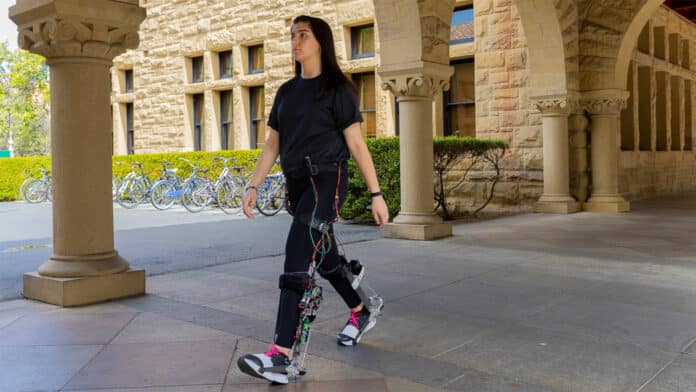Exoskeletons that assist leg movement show promise for enhancing personal mobility but have yet to provide real-world benefits. In research laboratories, exoskeletons can increase walking speed and reduce the energy required to walk, but these benefits have not yet translated to real-world conditions.
For years, researchers from the Stanford Biomechatronics Laboratory have captured imaginations with their exoskeleton emulators – lab-based robotic devices that help wearers walk and run faster, with less effort. The team has now unveiled its first untethered exoskeleton for use beyond the lab. This robotic boot adjusts the level of its assistance on the fly and offers a speed boost equivalent to “taking off a 30-pound (13.6 kg) backpack.”
The boot-like exoskeleton has a motor that works with calf muscles to give the wearer an extra push with every step. This push is personalized thanks to a machine-learning-based model that was trained through years of work using emulators.
Most existing exoskeletons are designed using a combination of intuition or biomimicry, but people are too complicated and diverse for that to work well. To solve this problem, the team relied on their exoskeleton emulators – large, immobile, expensive lab setups that can rapidly test how best to assist people and discover the blueprints for effective portable devices to use outside the lab.
By hooking subjects up to these emulators, the researchers collected motion and energy expenditure data to understand how the way a person walks with the exoskeleton relates to how much energy they are using. These data revealed the relative benefits of different kinds of assistance offered by the emulator. It also informed a machine-learning model that the real-world exoskeleton now uses to adapt to each wearer. Unlike the emulator, the untethered exoskeleton can monitor movement using only inexpensive wearable sensors integrated into the boot.
When a person is first using the exoskeleton, it provides a slightly different pattern of assistance each time the person walks. In addition, the machine-learning model determines how to better assist the person the next time they walk by measuring the resulting motion. It takes only about one hour of walking for the exoskeleton to customize to a new user. In tests, the researchers found their exoskeleton exceeded their expectations.
“Optimized assistance allowed people to walk 9% faster with 17% less energy expended per distance traveled, compared to walking in normal shoes. These are the largest improvements in the speed and energy of economy walking of any exoskeleton to date,” said Steve Collins, associate professor of mechanical engineering who leads the Stanford Biomechatronics Laboratory. “In direct comparisons on a treadmill, our exoskeleton provides about twice the reduction in effort of previous devices.”
The researchers next plan to see what it can do for the target demographic: older adults and people who are beginning to experience mobility decline due to disability. They are also planning to design variations that improve balance and reduce joint pain and to work with commercial partners to turn the device into a product.
Journal reference:
- Patrick Slade, Mykel J. Kochenderfer, Scott L. Delp and Steven H. Collins. Personalizing exoskeleton assistance while walking in the real world. Nature, 2022; DOI: 10.1038/s41586-022-05191-1
